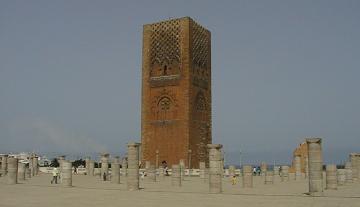
Rabat
August 21st - August 29th, 1999

We arrive in Rabat with not so much sightseeing in mind but rather with two priorities: to arrange our onward travel out of Morocco and to clear up our lingering health problems. Each turned out to be adventures in their own right and are described in the Health Note and Travel Plans sections below. In typical third world fashion, we had plenty of time to kill and found that Rabat has some very interesting sights to offer the tourist.
Hassan Tower and Mohammed V Tomb
Our first tourist sight dominates the low Rabat skyline. The Hassan Tower stands alone as a Moroccan historical site as it was never finished. Built by Sultan Yacoub al-Mansour, the Tower was meant to be his crowing legacy, surpassing the big minarets of Marrakesh and Sevilla. Begun in 1195 the minaret was built to commemorate a victory in Spain, but work was abandoned four years later upon the sultan's death. 44 meters tall, the minaret was originally meant to be sixty meters tall. The mosque built near the minaret was the largest in the world, but it was destroyed by the 1755 Lisbon earthquake. Only fragments of the mosque's columns remain, standing silently with the minaret in an oddly calm and contemplative vigil.
|
|
Opposite the plaza from the minaret is the tomb of King that successfully lead Morocco out from underneath French domination, Mohammed V. Honor guards in flowing white uniforms stand watch 24 hours a day over the marble building. Foreigners are allowed inside to view the tomb and marvel at the wonderful detailing and construction. Apparently, Hassan II's tomb is in a private part of this same building, and will someday be moved to a spot alongside his father.
|
|
|
Mohammed V was the father of the recently deceased king Hassan II. Flags in Morocco are still at half mast over the king's death, but the ban on alcohol and gambling has been lifted. The only restriction is that no festivals may be held for the remainder of the forty days mourning.

Chellah

At the south end of the city center lies the ruins of the first permanent human occupation in this part of North Africa. Sala Colonia, the first Roman city in Morocco (2nd century AD), was abandoned when Rome fell and subsequently became the Berber village Chellah. Later still, a mosque, koranic school and tombs of the Merenid sultans were added. It all was surrounded in 14th century by tall medieval walls and was its own independent village until the Lisbon earthquake of 1755 destroyed it all. Preserved in this state with lovely gardens all throughout, the Chellah makes for a wonderful morning of ruin exploring.
In the leftmost photo below, as you face Meccah you see the tomb of Sultan D'aboul-Hassan, buried in 752 AD. In the center Jim poses with the mosque and its new owners, the stork family. All around the ruins morning glories had taken over. In the rightmost photo the remains of an octagonal bathhouse with statue niches hint at its grandeur of 1800 years ago.
|
|
|
Below left is the fountain and pool at the center of the Koranic school, surrounded by dozens of study cubbyholes. Below right is the former Roman athletic center (no joke). It contained rooms for exercise and both hot and cold baths. The apparent bunching of branches in the background trees are stork nests. Apparently, the Chellah is home to over 150 storks.
Piecing it together in our minds' imaginations, we felt that this must have been a very grand and stately place for what essentially started out as a military outpost.
|
|
Kasbah and Museum of Moroccan Arts
Remember those stories and fables of pirates that used to plunder the trade between Europe and the Orient/Americas? Well, those pirates all came from Rabat. Called the Salle Rovers, they were descended from refugees chased out of newly christianized 16th century Spain and these guys were the scourge of the ocean throughout the 17th, 18th and 19th centuries. We have two travel books on Morocco and they tell conflicting stories on how the pirates were finally stopped. One says that Moulay Idriss sent Saharan mercenaries to clamp the lid down, and another says it was the British who stopped the pirates' romping. We lean toward believing the story about the British. Regardless, the kasbah (fortress) the pirates called home still exists and is a wonderful place to wander.
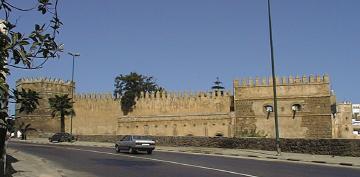
Inside the kasbah housed within a former palace is the Museum of Moroccan Arts. It's an interesting diversion, with relics dating back to the 13th century such as this astrolabe in the below left photo. You dialed in the date and the astrolabe would show you the current position of key stars, the moon and planets. To the right are two banjo like instruments that used actual human hair for strings.
|
|
Right outside the museum is a wonderful garden full of palms, hibiscus, bougainvillea, marigolds, and other tropical plants. A wonderful break from this hot morning's sun.
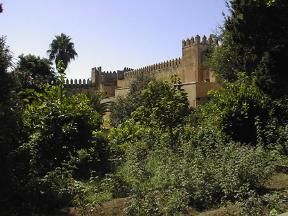
Archaeological Museum
By all accounts the best of Moroccan museums is the Archaeological Museum in Rabat. With exhibits tracing all the way back to Homo Erectus fossils from 100,000 years ago to roughly the time of the Romans, the museums has an impressive collection. The premier room houses marble and bronze artifacts from Sala Colonia (the Chellah) and Volubilis, an ancient Roman city near Meknes.
Clockwise from top, left: several fragments of Roman marble statues, including a beautiful bust of Juno, Jupiter's wife; a complete collection of bronze dentists tools; two bronze busts, the leftmost one a Roman and the rightmost a bust of Emperor Caracalla, the first Berber emperor of Rome. Finally at the bottom left is the most smiling bust of Hercules we've ever seen. Usually that guy is all business.
|
|
|
|
Just to make sure
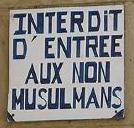 Since both Casablanca and Rabat have a few Islamic monuments and mosques
open to us infidels, the rank and file mosques here in Rabat have taken
the unusual step of leaving nothing to the tourists' imagination and posting
signs telling us that, yes indeed, we are not welcome here. Sorta gives
you a nice warm feeling, doesn't it?
Since both Casablanca and Rabat have a few Islamic monuments and mosques
open to us infidels, the rank and file mosques here in Rabat have taken
the unusual step of leaving nothing to the tourists' imagination and posting
signs telling us that, yes indeed, we are not welcome here. Sorta gives
you a nice warm feeling, doesn't it?
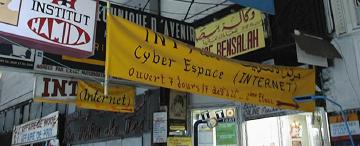
We experienced a 90's style drought all our travels through Morocco. Our last connection to the internet was July 25th when we were able to connect in Gibraltar. Once we entered Morocco, we crossed into the twilight zone of the cyberworld. Our international internet provider, IPass, has no local connections anywhere in the country. Every single internet cafe we found either wouldn't allow us to connect our laptop to their networks, or if they were willing to let us try proved to have networks configured in "imaginative" fashions. Most cafes used a single Windows 98 machine configured as a modem server with special software and weird proxy configurations to allow other machines access. Even those with more sophisticated ISDN lines usually had evolved from modem servers and had nudged their networks to the point where they work even though the cafe nerds really didn't understand why. I (Jim) spent two hours one evening at such an ad hoc cafe attempting to connect my Virtual PC setup (I gave up on the Mac side after an hour) and wasn't able to find the magic configuration -- even with the cafe owner's help.
Rabat is different. People running the cafes have some training and know what they're doing. One, in particular, not only would allow us to connect to his network but welcomed us to -- he says he gets a lot of travelers with laptops passing through. At 15 dirhams an hour ($1.50), the price is right and his ISDN connection sustained an honest 3K/second all the way to the USA.
Chatting with other travelers in INT Plus revealed that not only does IPass give Morocco a miss, so do all other international internet companies. One chap from Houston on an oil survey expedition did extensive research and found nothing, nada. Seems Morocco heavily regulates the internet industry and only allows home-grown service providers. I (Jim) did a few traceroutes of traffic from INT Plus and it seems that all internet traffic runs through some central choke point. This would allow Morocco to monitor and censor all internet traffic, and disconnect from the rest of the world if necessary. As if I needed a reminder that I'm not currently traveling in a free society.
One of our priorities for our time in Rabat is to take care of once and for all the nasty afflictions that have been dogging us throughout Morocco. Our lung infections have pretty much cleared up, but we both still have "the trots" and the sluggishness that goes with incomplete digestion. Our plan is to check with the US Embassy here in Rabat for a good English-speaking doctor we can accurately relate our symptoms to and see what he/she has to say.
The last thing we expected is a double-dose of good, old fashioned, American bureaucracy. Showing up at the embassy was an education in security procedures. It took them ten minutes to check our passports, thoroughly inspect our bags and persons, and retain our camera, pocketknife and other weapons of mass destruction. Then we were allowed into the middle compound to talk to a person through a two inch thick glass plate only to learn that the office of citizens relations had been move to Casablanca last month and that we would have to talk to them to find out a good English-speaking doctor.
Fine. We head back to our hotel, find a Teleboutique and call the number in Casablanca. After a back and forth conversation and then being put on hold for seemingly forever (burning dirhams all the while), the citizens relationship fellow dutifully reported back that we would have to talk to the Health Affairs department, and guess where that is? Rabat. Of course. So we call the number he supplied and found out it no longer works.
Ok. Well, at least we've got the system figured out now. Darned if we're going back to Fort USA, we call the main embassy number and ask specifically for the Health Affairs department. We reach a helpful woman who, after shuffling more paper than a Kansas tornado, comes up with a doctor who understands English and is near where we're staying. Dr. Alaoui is his name (phone: 70.80.29, fax: 72.30.43).
So we call the Doc up. He may speak English, but unfortunately his staff doesn't. Kathy through her French is able to make it understood that we need a check up for a digestive ailment. No problem, but the next time Dr. Alaoui can see us is three days hence. We'll take it.
On the day of our appointment, we set out early to locate the office -- as you see a month in Morocco has us taking nothing for granted. Guess what? We can't find it. The address is not a street address, but one on a square and although the square is crazy with doctors there are no offices with such an address. Not too much of a surprise, as half of the stores and offices have no address what-so-ever. Even asking the police got us the answer "it's over there somewhere." So, we head back to our hotel and ask if they have any idea of where this address might be. Taking the bull by the horns, they call up, get the Doc on the line and he gives us the hint we need ("it's by the bank"). Confused as we scoured that side of the street, we head back and find that a) the embassy gave us an incorrect spelling of his name (Laloui), and b) the address is not marked "6" but rather with "F" -- the sixth letter of the alphabet.
Finally our appointment time rolls around. A bit apprehensive, we found Dr. Alaoui to be both professional and knowledgeable -- and a Macintosh user! Although it's a bit of a stretch to say he speaks English. But with Kathy's French filling in the gaps in Dr. Alaoui's English we both get examined and are reassured that it isn't too serious. He sends us off with a list of things to pick up at the pharmacy.
This time it's war against those lower tract demons. We're to be nuked with drugs for Giardiasis (Flagentyl), and then followed up with stronger anti-biotics (Oflocet). All the while consuming a new kind of grout to minimize the effects of the anti-biotics (it's flavored vanilla this time). Our last drug dose cost us $5 for the two of us, but we suffered serious sticker shock when the total this time came to $100! Ouch!
We head back and wait until going to sleep to take the first round of medicine. You take the Giardiasis drug all at once, and the anti-biotics spaced over a ten day period. While Jim had no ill effects (he seems to be able to swallow any chemical with little harm), Kathy woke up in the evening with a splitting migraine -- one that sidelined her for most of the next day. But, a day later she bounced right back ready to take on the world. We likely won't be normal until we're through taking these very strong anti-biotics, but we're hopeful that this is the beginning of the end of our maladies.
Our intentions upon arriving in Rabat were to address our health issues and nail down our next destination. All along we had hoped to travel by ground along the west coast of Africa until we reached an active war zone, at which point we would hop on a big iron bird and avoid the gore. Turns out Morocco and its poor relations with its neighbors nixed that plan. You see, Morocco fought a war over the former Spanish colony of Western Sahara with it's southern neighbor, Mauritania. They eventually settled on a truce that gave Morocco the northern two thirds (and 80% of the world's phosphate reserves!) and Mauritania got the southern third. But when Mauritania tried to administer the region, local rebel troops gave them such a tussle that Mauritania decided to forget the whole deal and let Morocco have the entire Western Sahara. The war and total loss still left a bad taste in the Mauritanian government's mouth, so they make it a super, super hassle for anyone to get a visa for Mauritania in Morocco.
Actually, we didn't mind skipping over Mauritania. The only thing our tour books say is worth seeing is a bird sanctuary, but adds that the roads are diabolical -- if you can find someone to take you to it. Add to that the fact that Mauritania is the one of the last countries in the world that still condones slavery (it's also widespread in northern Sudan) and it's easy to classify it as a fly-over country.
Next down the coast is Senegal. While Americans are not required to have visas, the US State Department, Consular Affairs office (http://travel.state.gov/) states that if you arrive at the airport in Senegal's capitol Dakar with a personal computer or digital camera without proper import clearance, they will be confiscated. Rabat has a Sengalese embassy, so we headed on over and tried to get one. Fat chance. It took the embassy clerk three phone calls to confirm that we were indeed correct, but she (or anyone else there) knew nothing about the necessary forms. Their suggestion was "to hide them in our luggage." Great. That's reassuring.
While we do want to see the Île de Gorée in Senegal, the departure point for most of the slaves that entered America, there's not a lot else that really tickles our fancy in Senegal. All the good beaches are in the disputed southern region with lots of rebel activity. Senegal's neighbor, Mali, is far more interesting to us. So, a long session with a travel agent proved that there are flights from Morocco to Mali, but guess what? Mali doesn't have an embassy in Morocco. Of course not. Nearest ones are in Senegal and London. The only countries we can reach from Morocco are Senegal, Spain, Tunisia and South Africa.
Tunisia sounds intriguing, but it's hemmed in by Algeria and Libya, both pretty much off-limits to us Americans so onward travel would find us in the same bind we are now. We had planned all along to give it a miss and catch it along with a good, long trip through Italy some future day. No desire exists within either of us to go back to Spain this soon. Senegal is fraught with entry issues, and it turns out that now is the wettest and hottest time to visit. That leaves South Africa.
Back in our hotel room, we talk it over. After two months of baking in the hot Spanish/Portuguese/Moroccan suns, heading down to a land where spring is just starting sounds entirely refreshing. The whole of Africa from Namibia to Eritrea is open to Americans, and Johannesburg has embassies to every country in Africa. We even have the potential of exploring that whole swath with a vehicle of our own, if we desire to purchase one. Should South Africa be a little cold for our liking at the moment, we can always hop another plane and hit Madagascar for a month or so until spring catches hold back on the continent. Also, the tickets to South Africa aren't all that more expensive than those to Senegal.
It's decided. We book our tickets to Johannesburg for September 9th (9/9/99!). That gives us twelve more days to kill in Morocco, so we decide to hit a few high points we skipped over before and get train tickets to Meknes, the only Moroccan Imperial city we haven't seen.